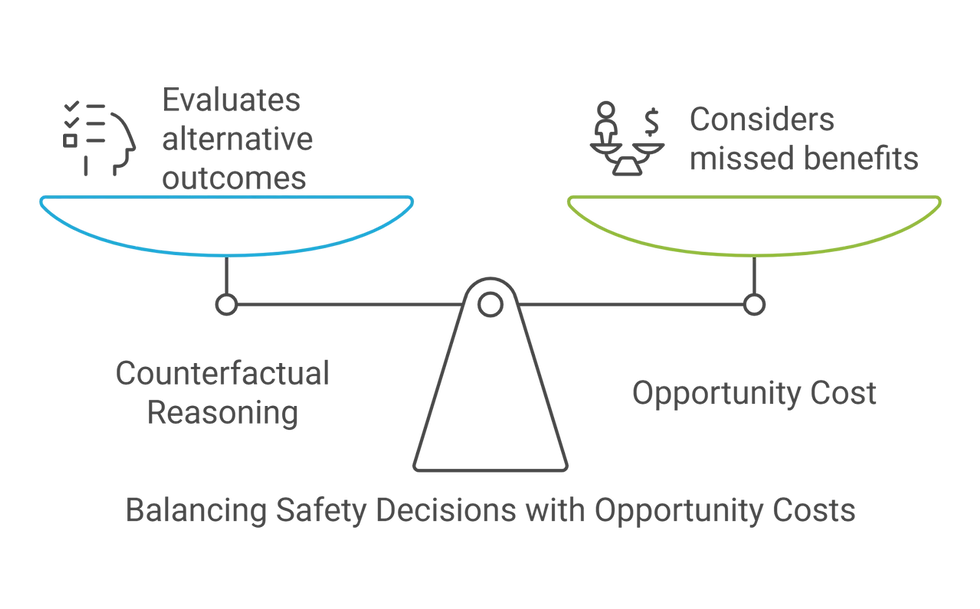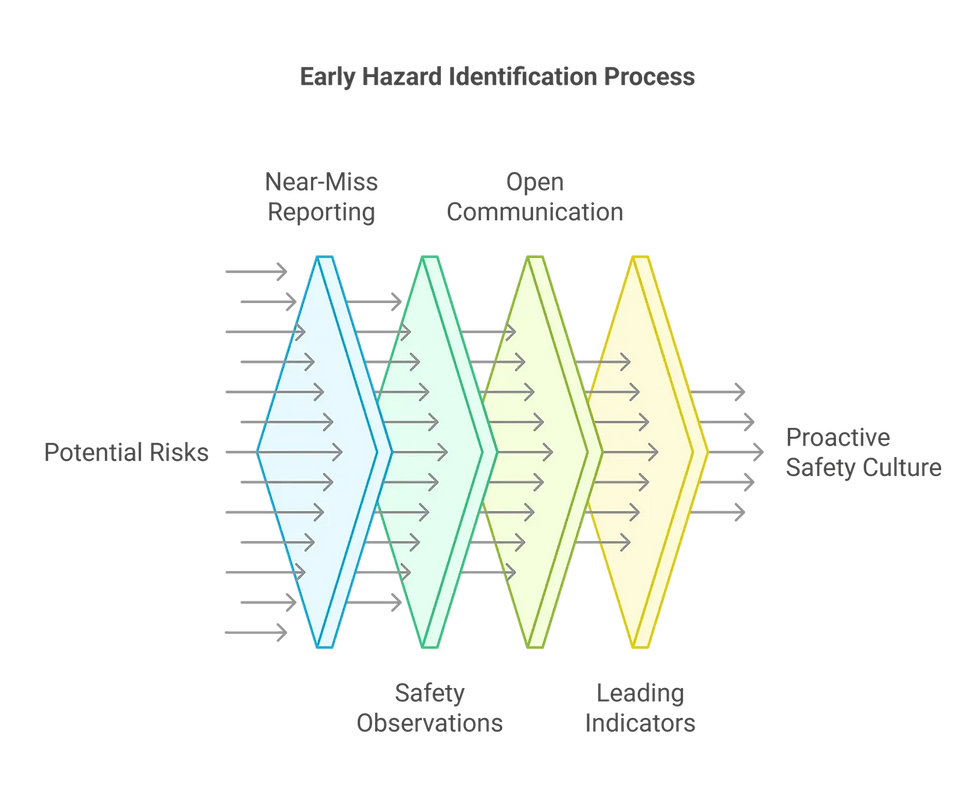Counterfactual Reasoning in Safety
- Reyka Ravenwood
- Mar 9
- 10 min read


Shifting from Root Causes to Systemic Improvement
In the ever-evolving landscape of workplace safety, the shift from traditional methods to innovative approaches like Human & Organizational Performance (HOP) is redefining how businesses address risk management. Rather than focusing solely on compliance and blame, this emerging mindset views workers as active participants in creating safety, not merely subjects of safety protocols. By emphasizing systemic improvement over root-cause analysis, HOP encourages organizations to explore counterfactual reasoning, which involves understanding what might have been instead of fixating on past failures. This transformative approach not only enhances resilience but also empowers employees to become proactive problem solvers, ultimately fostering a culture of continuous learning and improvement. Delve into how these principles can reshape safety strategies and elevate organizational capacity with me.
Understanding Counterfactual Reasoning
Counterfactual reasoning is a fundamental cognitive process that plays a crucial role in decision-making, problem-solving, and learning from experiences. We're going to explore the concept of counterfactual reasoning, its importance in safety practices, and its relationship to opportunity cost.
What is Counterfactual Reasoning?
Counterfactual reasoning is the mental process of imagining alternative scenarios or outcomes that did not actually occur. It involves thinking about "what if" situations and considering how events might have unfolded differently.
This cognitive ability allows us to reflect on past experiences, evaluate decisions, and anticipate future outcomes. By engaging in counterfactual thinking, we can identify potential improvements and learn from both successes and failures.
Counterfactual reasoning is not just about dwelling on the past; it's a powerful tool for strategic planning and innovation. It enables us to envision multiple possibilities and prepare for various contingencies.

Role in Safety and Decision-Making
In the context of safety and risk management, counterfactual reasoning plays a vital role in enhancing decision-making processes and improving overall safety outcomes.
By applying counterfactual thinking to safety incidents, organizations can move beyond simple cause-and-effect analyses. Instead, they can explore the complex interplay of factors that contribute to both safe and unsafe conditions.
This approach allows safety professionals to identify potential interventions and systemic improvements that may prevent future incidents. It also helps in developing more robust safety protocols and contingency plans.
Counterfactual reasoning in safety encourages a proactive mindset, where teams constantly ask, "What could go wrong?" and "How can we be better prepared?" This forward-thinking attitude is essential for creating a resilient safety culture.
In a nutshell, it has a lot of similarities with pessimism - but this is an area where the practice is socially tolerated, if not encouraged..
Link to Opportunity Cost
Counterfactual reasoning is closely related to the concept of opportunity cost in decision-making. Opportunity cost refers to the potential benefits an individual or organization misses out on when choosing one alternative over another.
When applying counterfactual thinking to safety decisions, we consider not only the direct consequences of our choices but also the potential outcomes of alternative actions we didn't take.
This perspective helps in evaluating the true cost of safety measures and interventions. It encourages a more holistic approach to risk assessment, where the benefits of safety initiatives are weighed against other organizational priorities.
By linking counterfactual reasoning to opportunity cost, safety professionals can make more informed decisions about resource allocation and prioritization of safety initiatives.



Traditional Safety vs. Human & Organizational Performance (HOP)
The field of workplace safety has seen a significant evolution in recent years, moving from traditional compliance-based approaches to more holistic, human-centered methodologies. This section compares the traditional safety paradigm with the emerging Human & Organizational Performance (HOP) approach.

Core Principles of Traditional Safety
Traditional safety approaches have long been the foundation of workplace safety programs. These methods typically focus on:
Compliance: Emphasizing adherence to rules, regulations, and procedures as the primary means of preventing accidents.
Hazard Identification: Systematically identifying and mitigating potential risks in the workplace.
Incident Investigation: Analyzing accidents to determine root causes and implement corrective actions.
Traditional safety often relies on a top-down management style, where safety policies are created by experts and enforced through supervision and disciplinary measures.
While these approaches have contributed to significant improvements in workplace safety over the years, they can sometimes lead to a culture of blame and may not fully address the complex, dynamic nature of modern work environments. There is also a significant amount of bias introduced - often due to Counterfactual Reasoning.
(Wait, did RJ just play a trick on us? Wasn't she just pro Counterfactual Reasoning?)
I'm getting there guys...

Key Tenets of HOP
Human & Organizational Performance (HOP) represents a paradigm shift in safety thinking. It recognizes that human error is a symptom of deeper issues within organizational systems and processes. Key principles of HOP include:
Systems Thinking: Viewing safety as an emergent property of complex systems rather than solely the result of individual actions.
Learning and Improvement: Focusing on continuous learning and systemic improvement rather than blame and punishment.
Worker Engagement: Actively involving frontline workers in safety processes and decision-making.
HOP emphasizes the importance of understanding work as it is actually performed, not just as it is imagined or prescribed. This approach recognizes that workers often create safety through their adaptations and resilience in the face of varying conditions. There is an instinctual element of 'best practices' that evolves out HOP naturally.
By fostering a culture of openness and learning, HOP aims to uncover and address the underlying factors that contribute to both successes and failures in safety performance.

Comparing Safety Approaches
To better understand the differences between traditional safety and HOP, let's compare their key aspects:

While traditional safety approaches have their merits, HOP offers a more nuanced and adaptive framework for addressing safety in complex, dynamic work environments. Many organizations are now adopting a hybrid approach, incorporating the strengths of both methodologies to create more resilient and effective safety systems.
[RJ's Sidenotes: But I have to wonder, is this hybrid approach enough? Or is it tolerating resistance to change? It can be said that change does not truly happen until the pain of change outweighs the pain of not changing... Something to chew on.]

Redefining Failure in Safety
The concept of failure in safety is undergoing a significant transformation. Moving beyond simplistic notions of human error or equipment malfunction, modern safety approaches recognize the complex, systemic nature of failures. This section explores how our understanding of failure is evolving and its implications for safety management.
Beyond Root Causes
Traditional safety investigations often focus on identifying a single root cause for an incident. However, this approach can be limiting and may not capture the full complexity of safety events.
Moving beyond root causes involves recognizing that failures are typically the result of multiple, interacting factors within a system. This perspective acknowledges that safety is an emergent property of complex systems, rather than simply the absence of errors.
By adopting a systems thinking approach, safety professionals can gain a more comprehensive understanding of how various organizational, technical, and human factors contribute to both safe and unsafe outcomes. This holistic view enables more effective prevention strategies and systemic improvements.

The Three Parts of Every Failure
Understanding failure in safety requires considering three key components:
The Context: The situational factors and conditions present at the time of the event.
The Consequence: The immediate and long-term impacts of the failure.
The Retrospective Understanding: The insights and learnings gained through analysis after the event.
Examining these three aspects provides a more nuanced view of failure. It allows organizations to move beyond simplistic cause-and-effect relationships and explore the complex interplay of factors that contribute to safety outcomes.
This approach also highlights the importance of learning from both failures and successes. By analyzing near-misses and positive outcomes alongside adverse events, organizations can gain valuable insights into their safety systems.
From "Who Failed" to "What Failed"
A critical shift in safety thinking is moving from asking "Who failed?" to "What failed?" This change in perspective has profound implications for how organizations approach safety and learning.
The "Who failed?" mindset often leads to blame and punitive actions, which can create a culture of fear and discourage open reporting of safety concerns. In contrast, asking "What failed?" focuses on identifying systemic issues and opportunities for improvement.
This shift encourages a more open and collaborative approach to safety. It recognizes that workers are often the last line of defense in a chain of system weaknesses, rather than the primary cause of failures.
By focusing on what failed within the system, organizations can create an environment where employees feel safe to report concerns and actively participate in improving safety processes.


The Role of Workers in Safety Culture
Workers play a crucial role in creating and maintaining a strong safety culture. This section explores how modern safety approaches recognize and harness the potential of frontline employees to drive continuous improvement and resilience in safety practices.
Workers as Solutions, Not Problems
Traditional safety approaches often view workers as potential sources of error that need to be controlled through rules and procedures. However, modern safety thinking recognizes workers as valuable assets in creating safety.
This shift in perspective acknowledges that workers possess unique knowledge and experience that can contribute to safer work practices. By viewing workers as solutions rather than problems, organizations can tap into a wealth of practical insights and innovative ideas.
Empowering workers to actively participate in safety processes not only improves safety outcomes but also enhances employee engagement and job satisfaction. This approach fosters a sense of ownership and responsibility for safety among all levels of the organization.
[RJ's Sidenotes: There has been a lot of repetitive dialogue surrounding this, many of us HR/HSE/QRC Professionals encourage our workforces to repeat this mantra after us like we're at a Yoga retreat. But the dirty secret is in the HOW to structure the actions that support the dialogue so that our field line trusts what is being said. Many of us are struggling with HOW to get to the fruition of an empowered workforce and then HOW to support our Operations Managers in maintaining the momentum of one.]

Harnessing Complex Adaptive Behavior
Workers often demonstrate complex adaptive behavior in response to changing work conditions and challenges. This ability to adapt and problem-solve in real-time is a critical aspect of maintaining safety in dynamic work environments.
Recognizing and harnessing this adaptive capacity involves:
Encouraging flexibility within safe boundaries
Providing workers with the tools and authority to make informed decisions
Creating opportunities for sharing and learning from adaptive practices
By supporting and learning from workers' adaptive behaviors, organizations can enhance their overall resilience and ability to manage unexpected situations safely.
It's important to note that harnessing adaptive behavior doesn't mean compromising on safety standards. Instead, it involves creating a balance between necessary procedures and the flexibility to respond to changing conditions effectively.
Safety in Real-Time: Workers' Insights
Workers are often the first to notice potential safety issues or opportunities for improvement. Their real-time insights can be invaluable in identifying and addressing safety concerns before they escalate into incidents.
To leverage these insights effectively, organizations should:
Create open channels for communication and feedback
Implement systems for rapid response to worker-reported concerns
Regularly involve workers in safety discussions and decision-making processes
[RJ's Sidenotes: These steps, if performed consistently, form a foundation of trust. The biggest barrier to forming that trust in my experience is ego - which gives us a chicken and egg scenario as the impact of the ego is often minimized by workforce culture. The workforce culture is what we're trying to change here though.]
By valuing and acting on workers' real-time insights, organizations can create a more proactive and responsive safety culture. This approach not only improves safety outcomes but also demonstrates to workers that their input is valued and respected.
Encouraging workers to share their observations and ideas also promotes a culture of continuous learning and improvement, which is essential for maintaining high safety standards in evolving work environments.

Building Capacity for Systemic Improvement
Creating a resilient safety culture requires a shift from reactive problem-solving to proactive capacity building. Here are strategies for enhancing an organization's ability to identify and address safety challenges systematically.
Early Hazard Identification
Early hazard identification is crucial for preventing incidents and building a proactive safety culture. By recognizing potential risks before they manifest as problems, organizations can take preventive action and allocate resources more effectively.
Key strategies for early hazard identification include:
Implementing robust near-miss reporting systems
Conducting regular safety observations and audits
Encouraging open communication about safety concerns at all levels
Utilizing leading indicators to identify trends and potential issues
Effective early hazard identification requires a combination of formal processes and a culture that values and rewards proactive safety behaviors. It's about creating an environment where everyone feels responsible for identifying and reporting potential risks.
Organizations should also consider leveraging technology, such as data analytics and IoT devices, to enhance their ability to detect and predict potential hazards in real-time.

Shifting from Blame to Learning
A critical aspect of building capacity for systemic improvement is moving away from a blame culture towards a learning-oriented approach. This shift is fundamental to creating an environment where safety incidents are seen as opportunities for improvement rather than reasons for punishment.
Key elements of this shift include:
Emphasizing the importance of understanding context and systemic factors in incident investigations
Encouraging open and honest reporting of safety concerns without fear of retribution
Focusing on forward-looking accountability rather than backward-looking blame
Celebrating and sharing lessons learned from both successes and failures
By fostering a learning culture, organizations can tap into the collective knowledge and experience of their workforce to drive continuous improvement in safety practices.
This approach also helps in building trust between management and workers, which is essential for effective safety communication and collaboration.

Implementing HOP for a Resilient Safety Culture
Implementing Human & Organizational Performance (HOP) principles can significantly enhance an organization's capacity for systemic improvement and create a more resilient safety culture.
Key steps in implementing HOP include:
Leadership Commitment: Ensuring top-level support and understanding of HOP principles.
Education and Training: Providing comprehensive training on HOP concepts to all levels of the organization.
System Analysis: Regularly reviewing and updating systems and processes to align with HOP principles.
Empowering Workers: Giving frontline employees the tools and authority to make safety-related decisions.
Continuous Learning: Establishing mechanisms for ongoing learning and improvement based on operational experiences.
Successful implementation of HOP requires a long-term commitment and may involve significant cultural changes within the organization. However, the benefits in terms of improved safety outcomes, employee engagement, and overall organizational resilience can be substantial.
Organizations should approach HOP implementation as a journey rather than a destination, continuously refining and adapting their approach based on feedback and results.


By building capacity for systemic improvement through early hazard identification, a shift from blame to learning, and the implementation of HOP principles, organizations can create a safety culture that is not only more effective but also more adaptable to the challenges of modern work environments.
⁉️ What are your thoughts? Have you ever seen HOP used in the workplace? Do you think there is bias in Root Cause Analysis? Drop a comment below!
Stay Connected
📰 Subscribe to our blog to stay updated on industry insights, best practices, and practical HSE strategies!
🕵️ Become a Member for more discussions on theories and methodologies like HOP.
☕ Buy Me a Coffee – If you found this article valuable, consider supporting my work! Your contributions help me continue sharing free industry knowledge.
Is your company struggling with this? Book a complimentary meeting with us and lets see what solutions are available for you.

Are you a HR, HSE or QRC Professional that's navigating these challenges in your Career? Book a complimentary Meet & Greet and let us help you get out of the weeds. You don't have to be a lone island!


$50
Product Title
Product Details goes here with the simple product description and more information can be seen by clicking the see more button. Product Details goes here with the simple product description and more information can be seen by clicking the see more button

$50
Product Title
Product Details goes here with the simple product description and more information can be seen by clicking the see more button. Product Details goes here with the simple product description and more information can be seen by clicking the see more button.

$50
Product Title
Product Details goes here with the simple product description and more information can be seen by clicking the see more button. Product Details goes here with the simple product description and more information can be seen by clicking the see more button.





Comments